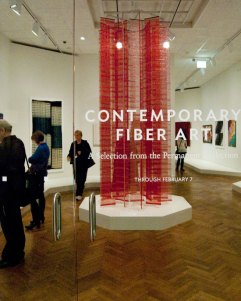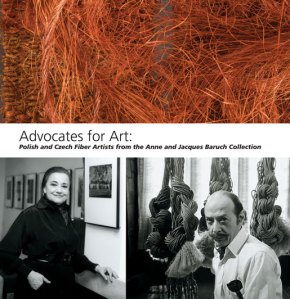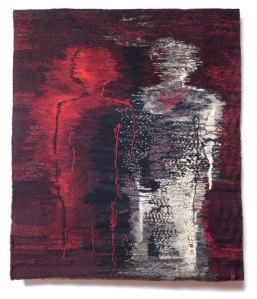We made a hurried trip to the Art Institute on the last day of SOFA to see Contemporary Fiber Art: A Selection from the Permanent Collection, the inaugural exhibition in the reopened Elizabeth F. Cheney and Agnes Allerton Textile Galleries, which were closed for five years during the construction of the Modern Wing. We walked there in the glorious morning sunshine, through a corner of Millennium Park, and entered the Institute from the bridge. Heading down to the textile galleries feels a bit like entering the basement, but once inside, the spaces are light and airy. The holdings of the Department of Textiles at the Art Institute comprise more than 66,000 sample swatches and 14,000 textiles ranging from 300 BC to the present. Extensive holdings of ecclesiastical textiles, 16th- and 17th-century velvets, 18th-century silks, 18th-20th-century printed fabrics, and lace are included in the department’s impressive collection of European textiles. Other notable holdings include American quilts and woven coverlets, historical fashion accessories, dress and furnishing fabrics and Japanese and Chinese holdings.

Helena Hernmarck's Mu1 and and its maquette next to Si Rothko M'etait Conte by Mariette Rousseau-Vermette photo by Carter Grotta
The Collection also includes more than 400 textiles and fiber art works from the 20th Century. These are not freestanding fiber works, sculptures vessels or baskets, for the most part, but wall hangings and ceiling-hung pieces. Sixty-one of these pieces are currently on display. Nonetheless it is an impressive grouping. The usual suspects are here – Lenore Tawney, Sheila Hicks and Claire Zeisler, Peter Collingwood and the Poles, Magdalena Abakanowicz, Zofia Butrymowicz and Jolanta Owidzka. But there are some surprises. Red Doors, by Robert D. Sailors, which graces the entrance is a show stopper. The Cynthia Schira that is included is an excellent piece. Helena (Barynina) Hernmarck’s 1965 abstract tapestry Mu1 is enhanced by the powerful painted maquette that is displayed alongside. The Mariette Rousseau-Vermette work, Si Rothko M’etait Conté (If Rothko Himself Had Told Me a Story)(which we assisted a client in donating) was luminous. We were delighted to see the tapestries floating off the wall, as we recommend, giving added dimension to the works. One quibble, the works in the cases in the conference room, which include a piece by Scott Rothstein, need to be better lit. Maybe motion detection lights would work, which would minimize energy use and uv exposure but still enable the works to be seen when viewers enter the room.
The items selected work well together, as curator Christa C. Mayer Thurman, emerita of the Department of Textiles, intended. The exhibition’s stated aim — to explore how fiber art has developed as an art form from the middle of the 20th Century through today and illustrate how the flexibility and variability of the medium encouraged artists to explore the potential of different fibers and methods — has certainly been achieved.












